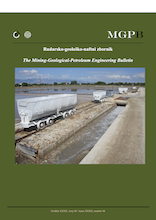Use of nuclear power plant released tritium as a groundwater tracer
DOI:
https://doi.org/10.17794/rgn.2020.1.3Keywords:
tritium, nuclear power plant, tracer, Zagreb aquiferAbstract
Tritium presents a natural radioactive isotope which can be used as a tracer in hydrology. This paper presents the usage of tritium in hydrogeological research of the Zagreb aquifer, which presents the country`s strategic water reserves and is protected by the Republic of Croatia. In the research area, higher tritium content in surface water and groundwater is the result of releasing coolant water from the Nuclear power plant Krško. Tritium content was measured in 13 piezometers and one pumping well, in the wider area of the Petruševec and Kosnica well fields. It has been shown that tritium from cooling water is much more pronounced than its natural seasonal variability, and it can be very useful as a tracer. Also, results showed that the intensity and delay of responses in the aquifer depend on their distance from the Sava River and piezometer depth. Furthermore, the results suggest that variable hydrologic conditions can generate rapid change in the groundwater flow direction and affect tritium transport through the aquifer.
Downloads
Published
How to Cite
Issue
Section
License
Copyright (c) 2019 authors and journal

This work is licensed under a Creative Commons Attribution 4.0 International License.
Creative Commons-BY
Authors who publish with this journal agree to the following terms:
In agreeing this form, you certify that:
- You read the ethical codex of the RGN zbornik available at journal web.
- You submitted work is your original work, and has not previously been published and does not include any form of plagiarism.
- You own copyright in the submitted work, and are therefore permitted to assign the licence to publish to RGN zbornik.
- Your submitted work contains no violation of any existing copyright or other third party right or any material of an obscene, libellous or otherwise unlawful nature.
- You have obtained permission for and acknowledged the source of any illustrations, diagrams or other material included in the work of which you are not the copyright owner.
- You have taken due care to ensure the accuracy of the work, and that, to the best of your knowledge, there are no false statements made within it.
- All co-authors of this submitted work are aware of, and in agreement with, the terms of this licence and that the submitted manuscript has been approved by these authors.
Publication licence
You retain copyright in your submitted work, according to journal license policy (CC-BY). By signing this form you agree that RGN zbornik may publish it under the publication licence. In summary the licence allows the following:
Anyone is free:
- To copy, distribute, display, and perform the work.
- To make derivative works.
Under the following conditions:
- The original author must always be given credit.
- The work may not be used for commercial purposes.
- If the work is altered, transformed, or built upon, the resulting work may only be distributed under a licence identical to this one.
Exceptions to the licence
In addition to publishing the work printed under the above licence, RGN zbornik will also enable the work to be visible online.
The journal editorial can change the licence rules anytime but it cannot retroactively restrict author(s) rights.


